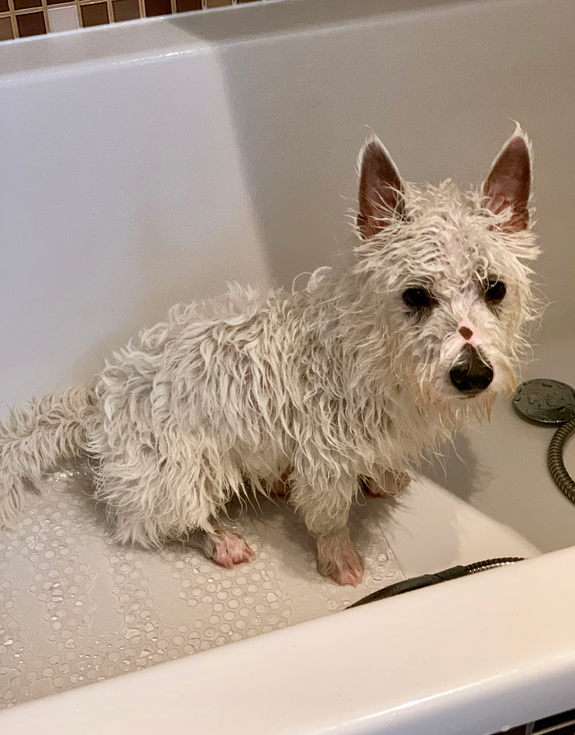By now, you should know that West Highland Terriers are my favorite terrier breed. Exhibit A: My adorable Sami. So, why is his breed impressive? To find the answer to that question, all you need to do is to look into their history.

Wouldn’t you want to know where they came from, their behavioral characteristics, and what their dog breed profile includes? The more you know about the terrier breed, the better you can care for them. Plus, knowing their origin story will make for one interesting conversation topic or an icebreaker. Have a look at the dog breed profile to increase your knowledge about Westies.
West Highland White Terrier: “Where Do We Come From”?
West Highland White Terriers come from Poltalloch, Scotland. The dog breed has been around for more than a century. A common belief is that all terriers belong to the same lineage. This includes Cairns, Scotties, Dinmonts, Dandie, and, Westies, Sami’s lineage.
People adopted Westies for hunting and companionship. Did you know Westies didn’t always have a white coat? Here’s the answer to the mystery of the white coat:
Malcolm, the Laird of Poltalloch, had accidentally shot his red terrier, mistaking it for a red fox, on a hunting trip. This saddened him so much so that it determined him to breed a terrier with a white coat to make them more noticeable in the forest.
Time for a quick story: When Sami is out for a walk with other dogs or playing with them, you can’t miss him, thanks to his white coat. If it snows, he’ll surely blend in with it.
West Highland White Terrier: “We May Be Small, but We’re Full of Energy”
West Highland White Terriers, lovingly called Westies, are small and energetic dogs. Take Sami for instance. When I adopted him, he was a ball of energy. He wouldn’t stop running and exploring every inch of his surroundings. If dogs with lively personalities warm your heart, give a Westie a home.
Another trait I discovered about Sami was how loyal, smart, and independent he was. He’s his ownboss in the house, but don’t fret, with some training, you can mold your Westie to become less independent, so both of you can live in peace together.
Also, don’t let their small body fool you because neither are they excessively muscular or dainty, they’re in the middle. If you’re still wondering if you should adopt a Westie, know this that they are counted as one of the dog breeds to bring home.
This adorable and cheerful dog breed is quite flexible and can comfortably live in most houses as well as apartments. Starting from a young age, I exposed Sami to other dogs, children, and took him to a dog trainer for lessons. All three things really helped shape his personality and I suggest you do the same after you adopt your Westie.
Overview of Dog Breed Profile
- Group:Terrier
- Height:10 to 11 inches
- Weight:13 to 20 pounds
- Color, Coat, and Length:Medium length white double coat
- Life Expectancy:13 to 15 years
Characteristics of Westies
- Affectionate:High
- Friendly:High
- Kid-friendly:High
- Pet-friendly:High
- Exercise Requirements:High
- Playful:High
- Energetic:Medium
- Training:High
- Intelligent:High
- Barking Tendency:High
- Shedding Tendency:Low
West Highland White Terrier: “We’re Not Divas, Just a Little Spoiled”
1. Grooming
West Highland White Terriers have medium length white hair. They have a coarse, stiff, and dry top coat and a fine and soft undercoat. You’ll have to groom, brush, or hand-strip, which is plucking dead hairs, one time each week.
I take Sami to a pet groomer to trim his coat after every four to six weeks. The best part about Sami is that he doesn’t shed a lot. This makes my job ten times easier. I also trim his nails regularly to keep his feet healthy.
2. Nature
One trait Westies share with their relatives — other terrier breeds — is that they are curious and remain alert. You’ll find them lively, but not energetic. Since exercise is crucial for their health, I have created a moderate exercise routine, which I plan to share in another blog soon, so you can follow it too.
However, it is not necessary that you follow my exercise routine for your pet, as your dog may require less or more exercise, but at least, it will give you some guideline to follow. I suggest talking to your vet first. I can give you some key indicators that tell you if they require less or more exercise.
A restless, bored, and overweight Westie requires more exercise whereas a healthy Westie requires less exercise.
3. Intelligence
Oh boy, Westies are one smart dog breed. They’re always up to learn new things and crave structure than chaos. Training them will help bring their intelligent and motivated side to the forefront.
4. Relationship with Other Animals
I don’t have any other pets at home except for Sami, but if you do, your Westie will become fast friends with them, including cats. However, Westies and small animals aren’t friends. If you’ve guinea pigs and gerbils, keep them away from your dog. It’s just that when they see small animals, their innate hunting nature comes out.
5. Separation Anxiety
In comparison to other small dog breeds, you can leave your West Highland White Terriers alone in the home or apartment. They will not go through separation anxiety if you do. Oh, and they’re not your usual lap dogs either. For instance, I don’t recall Sami sitting on my lap often, but he does stay close to me.
6. Professional Diggers
Every Westie, yours or mine, will dig in the garden and potted plants at one point in their life. This can become a huge problem if not discouraged. To fix the problem, take them to a dog trainer. He will train your dog not to dig by redirecting his attention each time he has the naughty urge to dig.
7. Loud Barkers
I’ve also had to train Sami not to bark, as excessive barking can become a problem, especially when Westies love to bark at people and animals. In fact, anything that moves will cause them to bark.
My West Highland White Terrier dog breed profile should give you a good idea of what you can expect from this breed if you choose to adopt them. Now, this is me and Sami checking out…bye and woof!





My dog Smitty, also a Westie, rarely barks. He just likes to stare or paw us when he needs something! He used to bark a lot when he was younger, but for the past few years he doesn’t really like barking much. When we go in the car he makes a high pitched whining sound , its very cute. Also I wouldn’t say he is very smart in terms of training anymore, he is 13. But Smitty loves to find new places to escape under the fence in our backyard, and sniff around our neighbors backyard!! hehe. Fortunately our neighbors do not mind at all. He does have a lot of separation anxiety especially for me, moving away to college was hard for him. But I get to be with him for quarantine!!! yay 😀 He loves to sit on my lap or next to me. He is a big snuggler.
It is cool to see the diversity of personality of our dogs, even though they are the same breed!
Hi everyone.
I have a 12 year old Westie called Ghost. We live in Ireland. I’ve only had him a year as my friends son took really sick so they could no longer care for Ghost. He has taken to my partner and I and we love him so much. We’ve had to take him to the vet recently due breathing problems/difficulties. We were informed that Ghost had a condition called ‘Westie Lung’which is genetic. We are devastated as there is no cure for it. Basically the disease causes scarring in the lungs which prevent normal breathing and exhaling. He is on a course of antibiotics aimed at alleviating the symptoms. I just hope he stays around for abit longer as I and my family love him to bits.